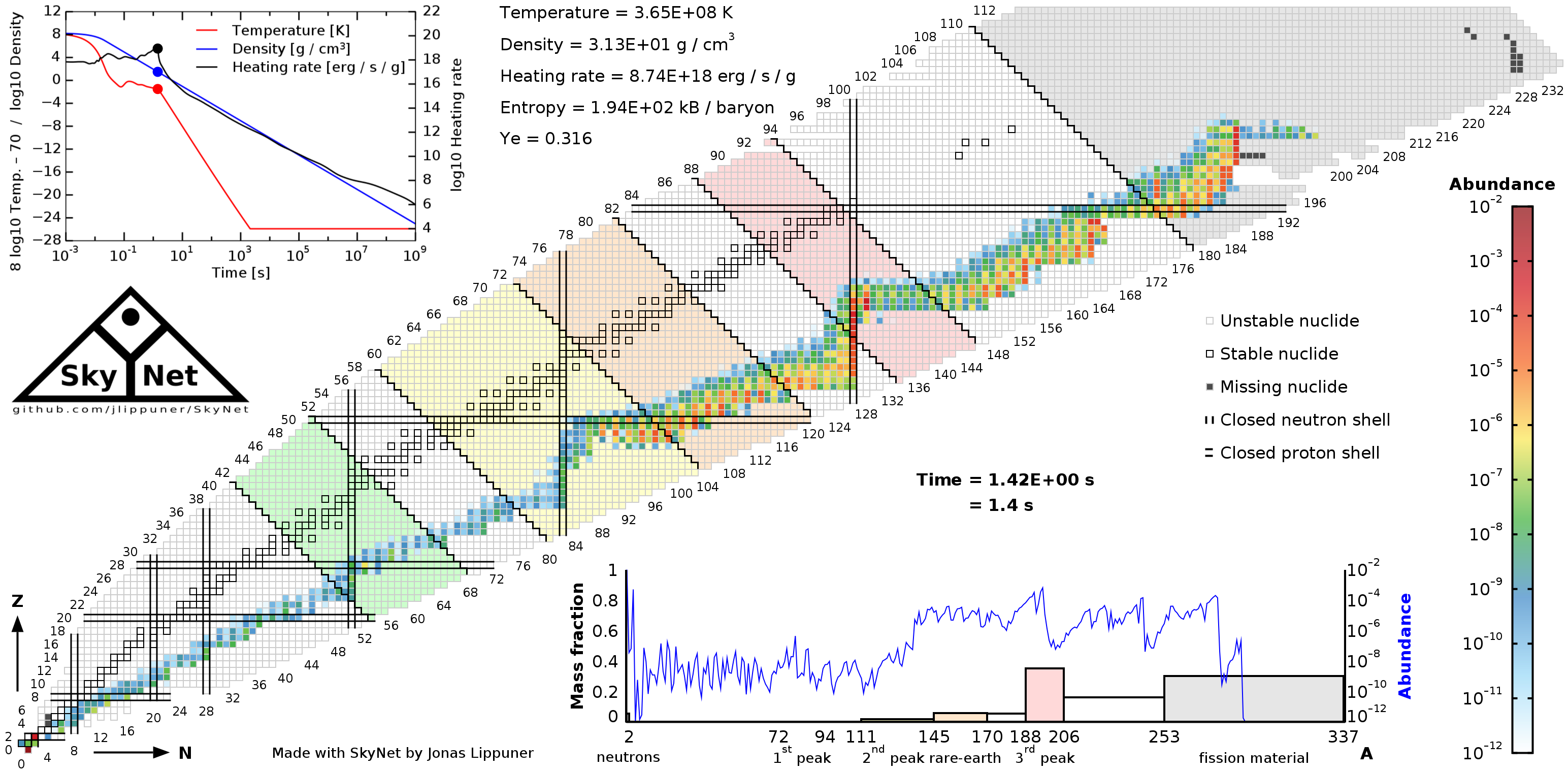Jonas Lippuner and Luke F. Roberts
The Astrophysical Journal 815, 18 (2015)
Abstract
| r-Process nucleosynthesis in material ejected during neutron star mergers may lead to radioactively powered transients called kilonovae. The timescale and peak luminosity of these transients depend on the composition of the material after nuclear burning ceases, which determines the local heating rate from nuclear decays and the opacity. Kasen et al. (2013, ApJ, 774, 25) and Tanaka & Hotokezaka (2013, ApJ, 775, 113) pointed out that lanthanides can drastically increase the opacity in these outflows. We use the new general-purpose nuclear reaction network SkyNet to carry out a parameter study of r-process nucleosynthesis for a range of initial electron fractions Ye, initial specific entropies s, and expansion timescales τ. We find that the ejecta is lanthanide-free for Ye ≳ 0.22 – 0.30, depending on s and τ. The heating rate is insensitive to s and τ, but certain, larger values of Ye lead to reduced heating rates, due to individual nuclides dominating the heating. With a simplified gray radiative transport scheme in spherical symmetry, we estimate the luminosity, time, and effective temperature at the peak of the light curves. We find that the luminosity peaks much earlier, at about a day in the lanthanide-free cases compared to a week in the lanthanide-rich cases. The heating rate does not change much as the ejecta becomes lanthanide-free with increasing Ye, but the light curve peak becomes about an order of magnitude brighter because it peaks much earlier when the heating rate is larger. We also provide parametric fits for the heating rates between 0.1 and 100 days, and we provide a simple fit in Ye, s, and τ to estimate whether the ejecta is lanthanide-rich or not. |
Simulation results
The simulation results can be downloaded in machine-readable form here: nucsyn_param_data.tar.gz (1.6M)
Please see the README file inside the tarball for an explanation of the individual files.
Animations
The following are animations of some selected nucleosynthesis calculations. Namely the ones whose abundances are shown in Figure 1 of the paper and whose light curves are shown in Figure 8. See below for an example frame and an explanation of what is shown in the animations.
| Initial electron fraction (Ye) | Initial specific entropy (s) | Expansion timescale (τ) | Animation |
|---|---|---|---|
| 0.01 | 10 kB / baryon | 7.1 ms | Ye_0.010_s_010.000_tau_007.100.mp4 (11M) |
| 0.19 | 10 kB / baryon | 7.1 ms | Ye_0.190_s_010.000_tau_007.100.mp4 (9.6M) |
| 0.25 | 10 kB / baryon | 7.1 ms | Ye_0.250_s_010.000_tau_007.100.mp4 (6.7M) |
| 0.50 | 10 kB / baryon | 7.1 ms | Ye_0.500_s_010.000_tau_007.100.mp4 (4.1M) |
| 0.25 | 1 kB / baryon | 7.1 ms | Ye_0.250_s_001.000_tau_007.100.mp4 (7.3M) |
| 0.25 | 3.2 kB / baryon | 7.1 ms | Ye_0.250_s_003.200_tau_007.100.mp4 (7.2M) |
| 0.25 | 100 kB / baryon | 7.1 ms | Ye_0.250_s_100.000_tau_007.100.mp4 (9.8M) |

A frame from the animation of the nucleosynthesis calculation for Ye = 0.01, s = 10 kB / baryon, and τ = 7.1 ms. The frame shows the full extent of the r-process just when free neutrons get exhausted. The plot in the upper left corner shows the temperature, density, and heating rate as function of time. The colored bands in the chart of nuclides correspond to the mass bins in the histogram at the bottom. The histogram shows the mass fractions on a linear scale while the blue curve shows the abundances as a function of mass on a logarithmic scale.
Slice plots
The complete set of slice plots (Figures 4 - 6 in the paper) is available in the PDFs below. Each PDF contains all the Ye, s, and τ slices of both the lanthanide and actinide mass fractions and the heating rate at 1 day.
| Parameter space | Neutron-induced fission reactions | |
|---|---|---|
| high-resolution | symmetric, 0 free neutrons | hires_sym0_slices.pdf (5.2M) |
| low-resolution | symmetric, 0 free neutrons | sym0_slices.pdf (3.0M) |
| low-resolution | symmetric, 2 free neutrons | sym2_slices.pdf (3.0M) |
| low-resolution | symmetric, 4 free neutrons | sym4_slices.pdf (3.0M) |
| low-resolution | non-symmetric, 0 free neutrons | nonsym_slices.pdf (3.0M) |
